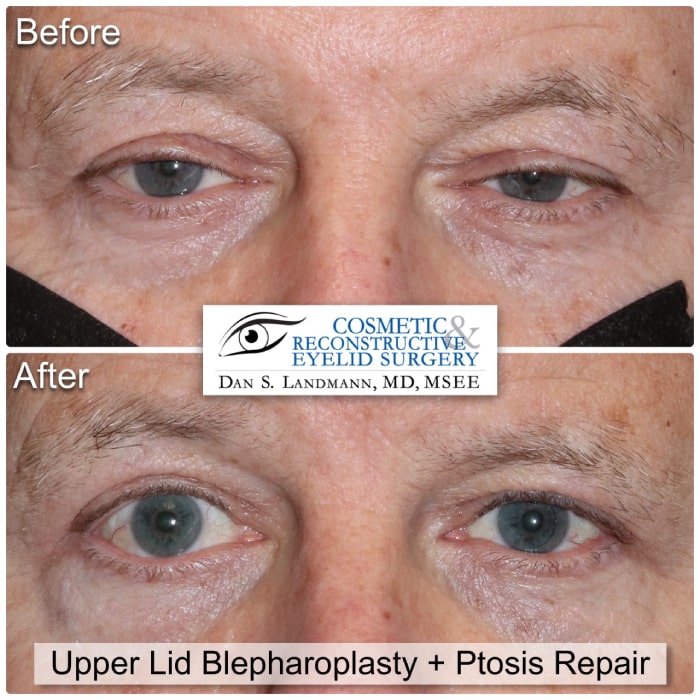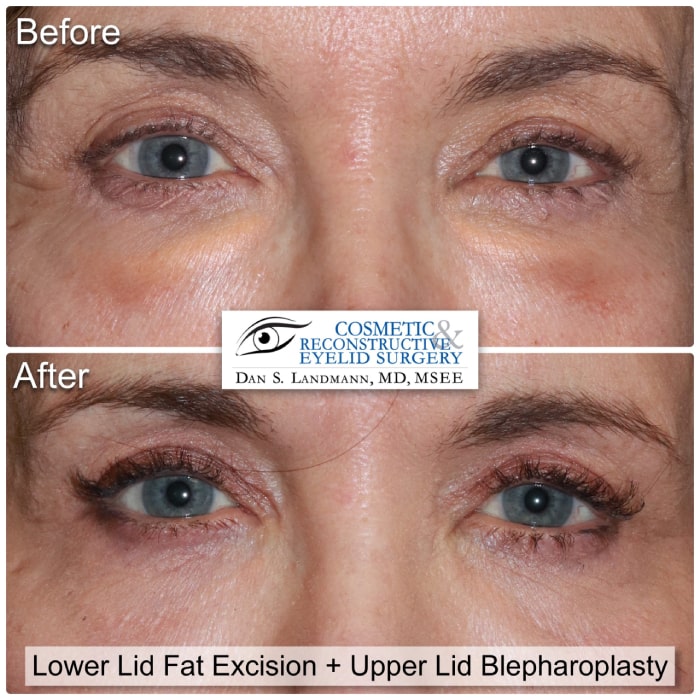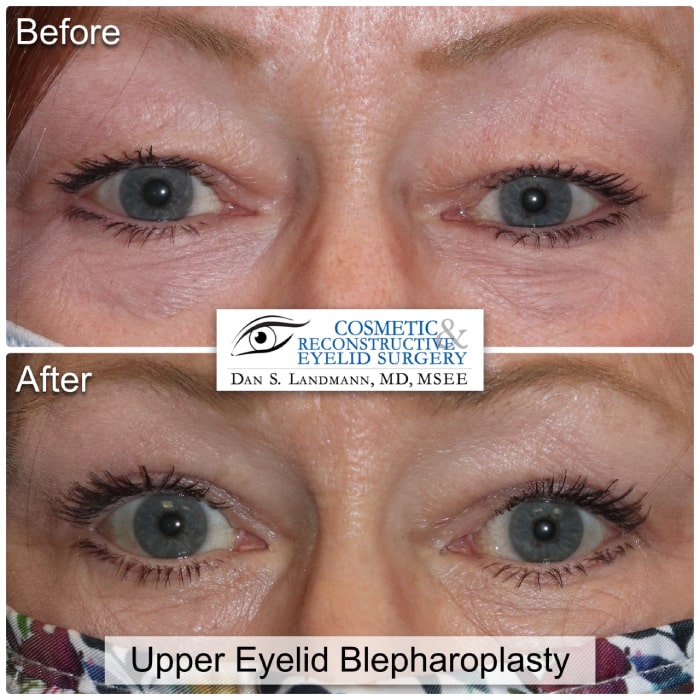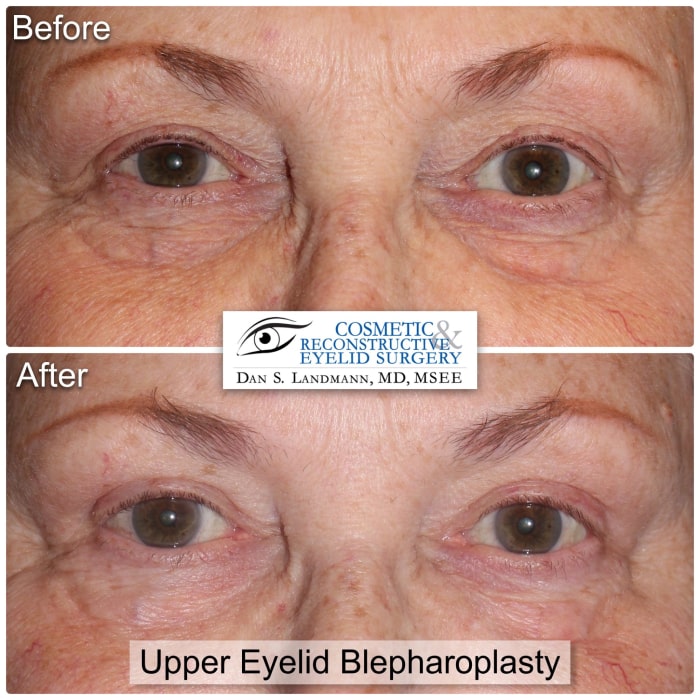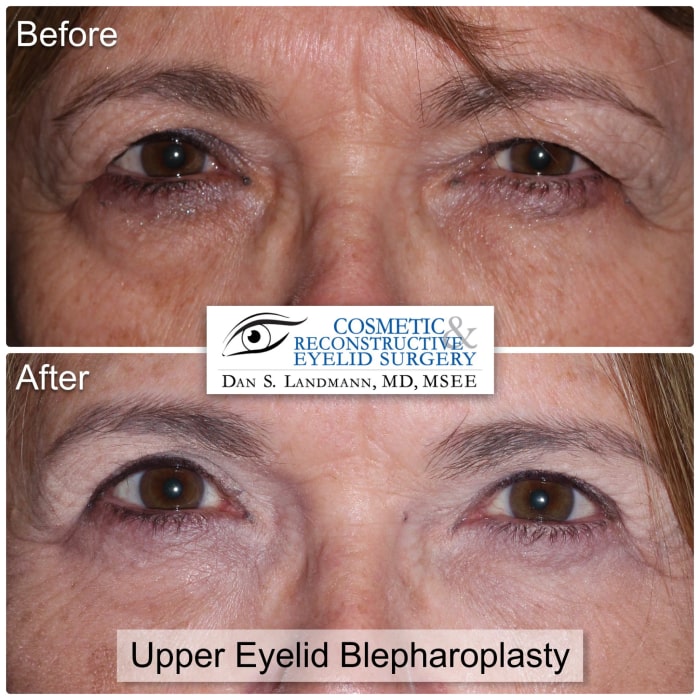Cosmetic Eyelid Surgery & Blepharoplasty

Why do Patients Get a Blepharoplasty?
But when I talk to patients on a deeper level, so many of them echo the same sentiment: that excess skin is a poor reflection of how they actually feel about themselves. So, while it’s not something that patients say out loud at first, I think a common impetus for having surgery is that they feel younger and more vibrant than they appear, and they want their eyelids to properly reflect how they feel about themselves.
REQUEST A CONSULTATION
+ GET
$250 Off
Blepharoplasty
*By submitting this form, I agree to be contacted via phone, text, email. Reply ‘STOP’ to opt-out of marketing at any time.
Blepharoplasty
(Greek: Blepharo means eyelid and plasty means to change)
What is Dermatochalasis?
Dermatochalasis is the technical term for having excess skin on your eyelids.
What is a Blepharoplasty?
Blepharoplasty is the technical term for an eyelid lift, where I remove the excess skin to make you look wonderful again!
At What Age Do People Get a Blepharoplasty?
There are so many different people in this world with different issues on their eyelids. I’ve operated on patients as young as 3 weeks old to 103 year olds for various different eyelid problems. For cosmetic reasons, the range is 20s to 80s, but most patients are between 40 and 70. Most patients who have surgery after around age 42 will see results for many, many years. Patients who are between 20-40 years old and bothered by their upper eyelids commonly have ptosis, which is similar but different. Age is really not at all important, as long as you are healthy – I actually pay very little attention to patients’ age.

What Can Cosmetic Eyelid Surgery Achieve?
- With a more defined lid platform and less overhanging skin - it will be easier to apply makeup without it smearing.
- If the skin is blocking your vision, you may feel that you have a larger field of vision after a blepharoplasty.
- Many patients report that they have a younger, fresher, more rejuvenated appearance.

Female Blepharoplasty -
“My eye makeup keeps getting smudged, will a blepharoplasty help?”
YES! I see patients all the time who are frustrated that their eye makeup smears. It’s very frustrating for patients who are trying to get themselves together for an event or a night out, and their makeup is all over the place. An upper eyelid blepharoplasty will remove the redundant skin that is hanging over the lid platform and allow you to put on makeup. A lot of my patients have avoided makeup for such a long time that they don’t even know how to do it anymore. If that’s you, let me know at your post-op appointment, and I’ll connect you with an excellent aesthetician who can come to your house and give you a personal lesson!
Male Blepharoplasty -
“My heavy eyelids make me look like I’m asleep at work.”
I see a lot of very successful and assertive men who have high-level careers but look sleepy and disheveled because their eyelids have so much extra skin. I enjoy doing male blepharoplasty surgery because the goal is to simply look well-kempt, like a nice haircut or trim, but not different. Men typically don’t want to look like they had eyelid surgery – so my surgical philosophy for men is surmised by the saying, “less is more.”
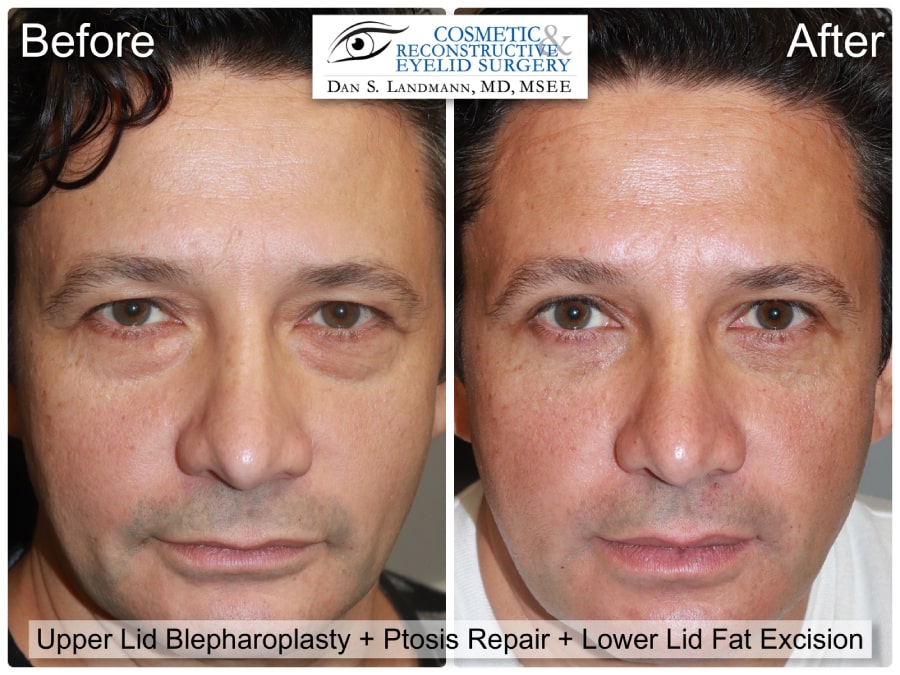
What is the Difference Between Dermatochalasis and Blepharochalasis?
Will I Have Natural Looking Results After an Eyelid Lift?
I strongly believe that “less is more” and that my goal should be to enhance a patient’s eyelids, not radically change anything. I have a very conservative approach to eyelid surgery. Success for me is when a patient meets up with an old friend who asks if you changed your hair. You should appreciate the difference, but it shouldn’t be super obvious to anyone walking down the street that you had something done on your eyelid. I love the emotion evoked by saying “subtle but dramatic.” In the past, surgeons used to cut off as much skin as possible, but there has been a paradigm shift, and the best plastic surgeons have now embraced the philosophy of removing as little as necessary. Success is measured in millimeters.
Who is a Good Candidate for Eyelid Surgery?
There are a ton of factors that go into figuring out who is a good candidate for cosmetic eyelid surgery. Some of the factors I look at are your:
- Past medical history, the medications you are taking, and any allergies
- Any surgeries or lasers that you’ve had on your eyes and any eye drops you are using
I’ll then examine your eyelids and review numerous before and after photos, to show you pictures of bruising and typical outcomes. I’m most interested in your goals, expectations, and questions – as that helps to frame our conversation. At that point, we have a discussion about the risks, the benefits, and the alternatives to surgery. I’ll explain what’s going on, what the cause and what the treatment would be. The best candidates are the patients that fully understand the conversation – but ask questions if they didn’t grasp something. Once we have that conversation – you should be able to decide if you’re a good candidate for surgery.
Surgical vs. Non-Surgical Blepharoplasty
Not everyone is ready for a blepharoplasty, and some patients are not good candidates for surgery. For some patients, I can do a “Botox Brow Lift,” which lifts the brows slightly and pulls the skin out of the way. This works best in younger patients who squint their brows and have prominent crow’s feet. A select few patients can get laser resurfacing of the upper eyelids. I tell patients that CO2 laser resurfacing is like ironing your pants, and blepharoplasty is like hemming your pants. If your pants are too long, ironing them won’t fix the problem, so I don’t typically recommend that very often. There are some injectors who talk about using fillers like Juvederm, Restylane, or Silikon-1000 in the Upper eyelids as a nonsurgical option. I see so many complications from fillers around the eyes from other providers, so allow me to be frank and state that I definitely do not recommend fillers into the upper eyelids (the lower eyelids are a different story).
A lot of my patients have tried Non-Surgical Eyelid Lifts before coming to me, and the consensus I get is that it was a lot of money, a lot of unfulfilled promises, and very marginal results. Meanwhile, a blepharoplasty is a “One and Done” procedure that takes 25-35 minutes. I do it in the office and never need to call in pain medications. So I rarely recommend nonsurgical options for a problem that really gets resolved with surgery because I don’t like to waste people’s time or money. But if you’ve had a different experience, please let me know. I’d be happy to update this section for others.
How Should I Prepare for my Consultation
with Dr. Dan Landmann?
- Your medications and any eye drops you’re using.
- Any medical problems you have or had in the past.
- Any eye problems, surgeries, or lasers that you’ve had.
I usually book out for surgery 1-3 months in advance, depending on the procedure length and season (Thanksgiving through February is very hectic). So, please come with your calendar if you want to get the surgical date that works best for you. In order to secure your surgical date, we also collect an administrative scheduling fee of $500-$1000, depending on the type of surgery.
How Should I Prepare for the Actual Procedure?
Well, the actual procedure day is usually a combination of nervousness and excitement for patients – which is normal for you to feel. Just know that I always feel excited about operating – because I love doing it and find it so rewarding.
About 1 month before
- Physical with your Primary Care Doc
- Blood work
About 1 week before
- Pick up the antibiotic drops/ointment
- If we’re doing the procedure without anesthesia – I usually call in an oral relaxing medication you need to bring to the appointment.
- Pick up some frozen peas and small zip-lock bags, which will help with icing afterward.
Day of the Procedure
- Wear comfortable clothes.
- Pro Tip: You may get a drop of blood on your shirt, so don’t wear your favorite designer shirt.
- We also put a grounding pad on the back of your calf, so tight jeans and leggings can be uncomfortable. Sweat pants are great.
You cannot drive yourself home, so you will need a ride, and your buddy Uber doesn’t count. If that’s an issue, let us know in advance.
How Long Does It Take For Dr. Landmann To Do an Upper Eyelid Blepharoplasty?
It typically takes me about 25-35 minutes to do the actual procedure. We ask patients to come to the office an hour before the procedure to take a relaxing medication by mouth (It’s a state rule that you have to take it in the office and not at home, plus we do it for your safety). It takes about 10-15 minutes for the room to be set up and for you to be connected to all the safety monitors. I take my time with the markings. The great thing about doing the procedure in my office is that there is no time limit, and you are not paying per minute of Operating Room time as you do at a surgery center or hospital. So, if I need a few extra minutes to get something perfect, I always take my time and am never rushed when operating. I have patients ice their eyes in the office for about 30-60 minutes while recovering to make sure that they feel comfortable before going home. Most patients are in the office for about 3 hours. Your driver can wait in our conference room, or we can call them when we’re done to pick you up.
What Type Of Anesthesia Is Used?
I would say that about 95% of my patients who have an upper lid blepharoplasty can do so with just local anesthesia – where I put a little numbing medication on the skin and I give you an oral medication to relax you. The nice thing about that is that you are always in control of your body – you can ask questions, you can talk, you can open and close your eyes – but you won’t feel anxious, and you won’t feel nervous. The medication starts to work quickly and wears off quickly, so you are back to your normal self within a few hours. There are tons of advantages to doing it this way.
- It is safer – anesthesia adds a layer of risks and should be avoided if possible.
- It is easier – You can do it in the morning, or you can go to work for a half day and do it in the afternoon. I do these cases every day of the week, so it makes it very easy to schedule.
- You don’t have to starve! If you’re having surgery with “twilight” sedation or “IV sedation,” then you can’t have anything in your mouth for 8 hours before the procedure, or it will get canceled. But if we’re doing it under local anesthesia, then you can have breakfast, you can have coffee, or you can have a light lunch before the procedure. That doesn’t mean you should stop at Suburban Diner and pound a plate of pancakes, but it’s totally fine to have a light meal.
- The recovery is faster, and there is less nausea and vomiting.
- It is less expensive – you don’t have to pay for an anesthesiologist!
- When my mom had her blepharoplasty, that’s how she had it done.
Now, some people are better suited for having it done with IV sedation or “twilight,” – which is also known as Monitored Anesthesia Care or MAC. This is performed with an anesthesiologist. If you take Xanax or Valium on a weekly basis, or if you have anxiety or Generalized Anxiety Disorder – then you will probably feel more comfortable with IV sedation. The two anesthesiologists that I work with are incredibly safe and conscientious. They will give you medication through an IV that makes you zonk out, but you are breathing on your own the whole time – you do NOT need a breathing tube, so it is NOT general anesthesia. The nice thing about IV sedation is that you don’t feel, hear or see anything during the procedure, but you’re breathing on your own the whole time.
What Should I Expect During Eyelid Surgery?
What is the Recovery Like for an Upper Eyelid Blepharoplasty Procedure?
After the surgery, I will personally review all the instructions with you. The most important thing is to ice your eyelids as much as possible for the first 48 hours. The patients who ice their eyes the most always heal the fastest! If you can, sleep with your head elevated – either propped up on some pillows or in a chair. I typically prescribe an antibiotic ointment for patients undergoing dermatochalasis surgery. The ointment goes on the outside of the eyelid four times a day.
We typically recommend not exercising or lifting heavy objects for 5 to 7 days. You can shower the day after the surgery. If you had stopped any medications before the surgery, like a blood thinner, I will usually defer to the doctor who prescribed the blood thinner to tell you when to resume that medication. But most patients can resume their regular medications the next day.
The most important rule after surgery is to call or text me if you have any questions or concerns! You will have my personal cell phone number, and I always prefer that patients call or text me directly if they are having a problem. It takes me one second to look at a picture of your eyelids – and if everything is good, no one has to worry. But if there’s an issue, I want to be able to take care of it as soon as possible.
On that note, if you ever have a question or a concern after surgery (1 day or 10 years later) – I want you to come in. Once I operate on a patient, I take ownership and responsibility for you and will do everything I can for you.
Here is a video of me talking and going over the postop instructions in a little more detail.
What Are the Milestones After Eyelid Surgery?
My team and I typically see patients about 1-3 weeks after blepharoplasty. I use dissolvable sutures that don’t need to be taken out. But if they’re bothering you, or you want us to take them out, we do so at that appointment. Taking out the sutures takes less than a minute and is easy for patients. We usually check up on patients at the six-week mark on the phone to make sure everything is healing well and see if you have any questions. The most important milestone for a blepharoplasty surgery is the 3-month mark, so we have patients come in at that time to confirm that the eyelids are healing perfectly. Some patients get little lumps and bumps along the incision line. Those always go away, usually by about 3-6 months, but if they’re bothering you, I can inject them with a little steroid. The full healing after eyelid surgery takes a year. You’ll see the incision fade over the course of a year, and it typically heals incredibly nicely.
Upper Eyelid Blepharoplasty FAQs
Who is Not a Good Candidate for a Blepharoplasty?
My primary concern is always safety. I think that is the most important thing as a doctor. So, there are a couple of risk factors for problems after eyelid surgery.
- Dry Eye – If you just have a little dry or sandy sensation in your eye occasionally, then I would have to examine you and have a personal conversation with you to determine if it is safe to have a blepharoplasty. But people who have a lot of irritation and discomfort and need to use several drops a day would need to have the dryness fully managed before undergoing surgery.
- Patients recently diagnosed with a Thyroid condition – Believe it or not, the thyroid can have strange effects on the eyelids, so if you were recently diagnosed with any thyroid condition (in the past 18 months), I have to make sure things are stable before proceeding with surgery.
- Patients on blood thinners like Plavix, Clopidigrel, Baby Aspirin, Warfarin, or Pradaxa AND can’t stop it before surgery – If you can’t stop your blood thinner before surgery, I don’t recommend surgery. If the doctor who prescribed the medication allows you to hold it for a few days, then it’s worth having a discussion about how that will affect your risks.
- People with unreasonable expectations, uncontrolled depression, or PTSD – Depression is very common, and as long as it is well controlled and you have a support system and therapist or provider (psychiatrist/psychologist/primary care doc) taking care of you, it should be OK. Patients who recently went through a traumatic life event (death in the family, divorce, lost job) should wait a few months to make sure everything is stable.
- Prior Eyelid surgery & Trauma -These are two risk factors for having difficulty closing the eyelids after surgery. So, while I commonly perform Revisional Eyelid Surgery, these need to be evaluated in person.
Where is the Incision Made in the Upper Lids for an Upper Eyelid Blepharoplasty?
For an eyelid lift, I make the incision in your natural lid crease. This is nice because it is hidden and heals really well. Unless you are closing your eye and looking for it, you usually don’t see it. It is also not under tension, so it heals really well. If you have a lot of hooding in the outside corners, then I have to extend the incision, but I do so in the natural crow’s feet that most people have. So, this, too, heals really nicely.
Will There Be a Scar on My Eyelid?
The skin on the eyelids is the thinnest on the body and is blessed to heal very well. The incision heals over the course of the year, and the big milestones are 3 months, 6 months, and 12 months. Some patients get little bumps on the incision line that usually fade by 3-6 months but can be enticed to go away sooner with a massage or, if they are really persnickety, with a steroid injection. The incision fades over the course of a year.
Some patients who have had keloids on other body parts and African Americans are understandably worried about keloids. But there have been no keloids reported in the literature after cosmetic eyelid surgery.
Is Eyelid Surgery Painful?
The procedure is surprisingly uneventful. I’m so amazed at the advances in surgery, to the point where I’m able to have someone come into my office, have surgery on their eyelids, and most patients either fall asleep or laugh at my singing. Honestly, I have at least one patient every week say, “It was so much easier than I thought it would be.”
Afterward, I’ve never needed to call in narcotics. I tell patients to take Tylenol every 4 to 6 hours after surgery. Most patients will take Tylenol that night and the next day. Some patients might need it for a third day. But some patients don’t ever need any Tylenol!
When Can I Return to Work and Normal Activities After Having Eyelid Surgery?
Most people can get back to work about 5-7 days after an upper lid blepharoplasty. I’ve had one patient, an accountant, come in the morning for surgery, go to lunch, and then go to work that afternoon. I don’t recommend it, but she did it. I also operated on an ophthalmologist who went back to seeing patients 1 week later and operating on patients’ eyeballs 2 weeks later. If you can work remotely, you can probably get back a little sooner. If you have a very visually demanding job, like a bookkeeper, a nurse, a doctor, or an engineer, set aside a week and a few days just because your vision might be ever so slightly blurry, but it’s usually not a problem.
I ask patients not to work out for 7 days after eyelid surgery. There are thousands of tiny little capillaries, and anything you do that gets your heart pumping can make the eyelids bleed more. After 7 days, you can work out. Just ease back into it so you don’t hurt yourself.
What Procedures Can Be Combined With A Blepharoplasty?
I’m not very pushy about selling cosmetic procedures, so if the only thing that is bothering you is your upper eyelids, I’d tell you just do your eyelids, and you’ll feel great. That being said, the other surgeries I commonly perform at the same time as an upper lid blepharoplasty are ptosis surgery (for droopy lids) and lower lid blepharoplasty (for bags under the eyes). A really great thing to do at the same time as eyelid surgery is laser resurfacing because that really freshens up your skin in an amazing way, but the downtime is about 2 weeks, which overlaps with the downtime that you’ll have anyways. Either me or my nurse practitioner can also do fillers at the same time because there is some bruising with fillers, especially around the lips and mouth.
How Much Does Upper Lid Blepharoplasty Cost in New Jersey?
The total cost of upper eyelid surgery in Northern New Jersey can be around $5000-$7000. It will depend on numerous factors. The three biggest fees are the surgeon’s fee, a facility fee, and the anesthesia fee. The surgeon’s fee is the cost of the actual procedure, and for my practice, this includes the preoperative consultation, the surgery itself, and the postoperative visits. If something needs to get tweaked, I also do not charge patients, as my goal is to get it as perfect as possible, and everyone heals differently. The facility fee is the cost of the supplies and the facility itself. Since the vast majority of my cases are done in my office, you’re just paying for the supplies and equipment since so much stuff is disposable, i.e., gauze, needles, sutures, etc. I also do most of my cases with local anesthesia and just an oral relaxing medication, so most people don’t need an anesthesiologist. If you’re very nervous, or we’re doing a revision or a lower lid blepharoplasty, then the anesthesiologist fee is to pay for a doctor to be there to provide “twilight” sedation. The following may not apply to everyone: some random fees that patients may have are History and Physical with Primary care doc, blood work, EKG, and erythromycin ointment medication (which costs $12.15 without insurance).
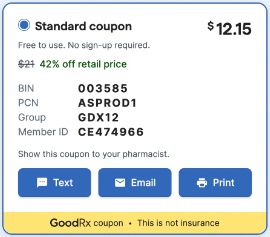
Does Dr. Landmann Have Financing Options?
Yes, financing has made the procedure very feasible for a lot of patients. This is a conversation between Melissa, my Cosmetic Patient Care Coordinator, and myself talking about financing options, and she answers all the common questions we get!
How Long Will My Blepharoplasty Results Last?
I like to tell patients that when they do the procedure after age 42, it usually lasts them for most of their life. They shouldn’t need to repeat the procedure. I do see a lot more patients in their 30-40s, and those patients may need to repeat it in a few years because they typically just have much more loose and lax skin than the average person who didn’t need it until later on in life. I’m 44 and hope to be doing this for decades to come, so time will tell how long it really lasts.
I Am Interested! How Should I Proceed?
Great! If you’re interested in eyelid surgery, I would love to help you! I really love doing eyelid surgery, and I find it so fulfilling to help patients with their questions and concerns, and I find it so enjoyable to see their results and hear how it impacts their lives.
So, if you’d like to learn more and proceed, then please call the office at 201-696-2646, and Melissa or Joanna can help you make an appointment. They are going to give you some information and will also need to get some information from you in order to schedule an appointment. Once you’re here, we’ll be able to make a detailed, customized treatment plan specific to your needs. I typically book out about 1-3 months for an appointment and then another 1-3 months to schedule surgery. The fastest way to get in is to call the office directly or fill out this contact form. Thank you again, and I’m looking forward to meeting you!
REQUEST A CONSULTATION
+ GET
$250 Off
Blepharoplasty
WHAT OUR PATIENTS SAY ABOUT US
Wonderful Care and Experience
Wonderful experience. For years I had felt self-conscious about the bags under my eyes but was too afraid to address them. I was nervous about the recovery time, and especially the procedure itself. Unfortunately, as I aged, the bags became more pronounce. Finally, on the recommendation of my GP, I met with Dr. Landmann. I immediately felt at ease and confident this issue could be resolved.
The BEST for Ptosis Surgery
Dr. Landmann is the best. I came in to have my congenital ptosis taken care of and he did a perfect job. He was very professional, friendly, and detail-oriented every step of the way; from consultation to post-op check up. He answered all of my questions in an easy-to-understand way. I have nothing but good things to say about my experience at Bergen Eyelids!

Matthew M.
Dr. Landmann and staff are simply AMAZING! I always have a wonderful experience here. Dr. Landmann is incredibly knowledgeable and professional. His staff are very welcoming and friendly. I highly recommend!
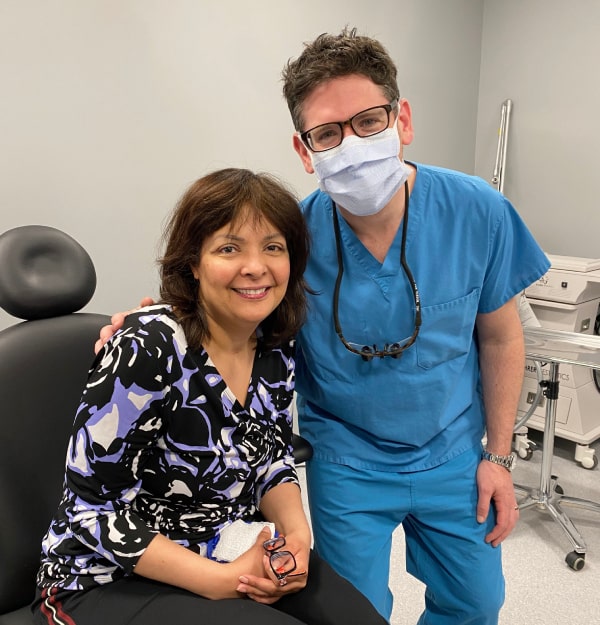
Judy R.
Dr. Landmann and his staff were EXCEPTIONAL!! The entire visit was seamless… everyone caring, efficient, professional, and accommodating! I highly recommend Dr. Landmann to anyone in need of any surgery!!
Hands Down He’s the BEST!
Dr. Landmann is very calming and really knows what he is doing. I cannot complain of having pain. I believe it was due to the fact that I was very consistent on putting ice on throughout the first night and following day. I actually did very well throughout the entire recovery. Dr. Landmann is the best. I highly recommend him to anyone who is thinking of having some kind of procedure. He and his staff are professionals who care and perform the best service possible.
I am extremely happy! I will be a life long patient.
Extremely Pleased and Totally Satisfied
Doctor Landmann, I want to thank you and your wonderful staff for the exceptional service you given me during my recent surgery. I truly appreciate the caring manner, in which I was treated. It completely eliminated the anxiety and nervousness that I usually experienced during previous medical procedures. You and your staff were extremely patient with me and gladly responded to the many questions I had during each of my visits and on the day surgery. Your explanations of the process and the directions provided both before and after surgery were very precise and informative and were very helpful to me to understand and prepare myself for both the surgery and recovery process. I want to express how happy and satisfied I am with the results of my surgery and how grateful I am to you for the exceptional and professional manner, in which you performed it. Again, thank you so much.
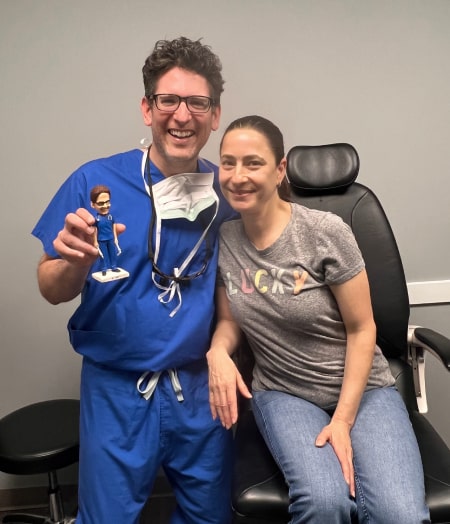
By Far the BEST!!!
I went to 3 different doctors for a consultation and I felt the most comfortable and confident with Dr.Landmann. I am beyond happy with my decision and my results with the surgery. Dr.Landmann was professional, kind, and caring. I would highly recommend Dr. Landmann.
Areas We Serve
- By submitting this form, you agree to be contacted by BergenEyelids for marketing messages via text, phone, or email. We respect and protect your privacy, and you can unsubscribe from these messages at any time. Review our Privacy Policy for more information.
- Before and after images reflect actual patient results, although individual results may vary. A guarantee is neither provided nor implied.
- $250 Off Surgery is intended for new patients only. Can only be used for Cosmetic Surgical Procedures and cannot be used or applied to Consultations, injectables, lasers, non-surgical procedures, insurance balances, or deductibles. We revamped our website and are using this to see who finds us through our website. Cannot be combined with any other offers or services.

